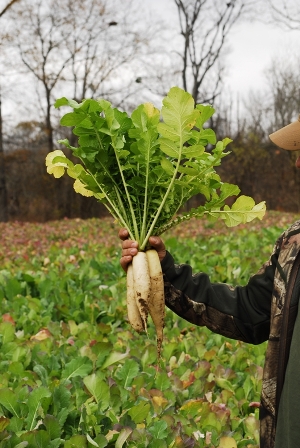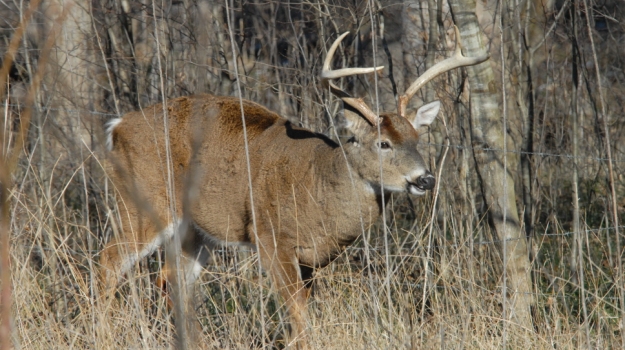Editor’s Note: Chris Kirby has been wearing Mossy Oak most of his life and is the president of Quaker Boy Calls. Through partnering with Mossy Oak, he produces the Deer Thugs line of deer calls. Although Kirby lives in Orchard Park, New York, he hunts all over the country and helps manage several small farms in his area - some as small as 25 acres and others as large as 200 acres. Kirby says, “You definitely can manage deer to produce mature bucks on small properties. Here’s how we do it with 15 members in our hunting club.”
In the late season, I believe your ability to take older-age-class bucks totally depends on planting the right crops during the late spring and early fall in designated food plots. When you're planting food plots, most people think about planting crops that they can hunt over in the early season. They rarely consider planting late season food plots. But here’s why you should consider planting last season food plots:
- You’ve got to remember your bigger bucks will be chasing does day and night during the rut;
- Their bodies will be in poor condition;
- They’ll have lost much of their body weights;
- Food is the main thing on their minds.
 In the spring to mid to late summer, I'm thinking about what I can plant, so I’ll have a food crop to hunt over during the late season, and how can I plant multiple food plots for the late season to give the deer a choice of foods they can eat when there's very little food available. I always plant Mossy Oak BioLogic Clover Plus, Deer-Radish, Winter Bulbs and Sugar Beets and Maximum. I’ll even plant winter rye for late season hunting. To keep from dying, the deer have to replenish their nutrition that they’ve lost during the breeding season. The real secret to winter food plots is to plant big food crops for late season hunting, because you’ll also need to have food available for does. During the first rut, all the does may not have been bred. If you’ve got plenty of food for those does in the late season, they’ll come in and feed on your food plots just like your mature bucks. If one or two of those does that are feeding on the food plot still need to be bred during the late season, you have a buck’s magnet out in that food plot.
In the spring to mid to late summer, I'm thinking about what I can plant, so I’ll have a food crop to hunt over during the late season, and how can I plant multiple food plots for the late season to give the deer a choice of foods they can eat when there's very little food available. I always plant Mossy Oak BioLogic Clover Plus, Deer-Radish, Winter Bulbs and Sugar Beets and Maximum. I’ll even plant winter rye for late season hunting. To keep from dying, the deer have to replenish their nutrition that they’ve lost during the breeding season. The real secret to winter food plots is to plant big food crops for late season hunting, because you’ll also need to have food available for does. During the first rut, all the does may not have been bred. If you’ve got plenty of food for those does in the late season, they’ll come in and feed on your food plots just like your mature bucks. If one or two of those does that are feeding on the food plot still need to be bred during the late season, you have a buck’s magnet out in that food plot.
I prefer to hunt during the first hour of daylight or the last hour just before dark. But having the food and knowing when to hunt is only one of the ingredients to taking an older-age buck in the late season. You have to make sure you hunt with a favorable wind and that you and your clothes are totally scent-free. By the late season, mature bucks know what a hunter smells like. If they smell you, you'll never see them. Also, realize that a mature buck will wait until just about dark or after dark before he steps out on that green field. So, I look for a secondary food source where that buck may try to feed on naturally occurring food during the late season before he moves out onto the green field.
One big mistake that many late hunting season hunters make is that they take a stand on the main trails leading to the food plot. These trails will have the most tracks, droppings and usually scrapes and rubs. But I've found that mature bucks will be walking secondary trails that are about 20 - 50 yards off the green field and intersecting the main trail. A mature buck will use his nose to scent check a green field to tell him whether there's an estrous doe out in that field or not. If there's not an estrous doe in the green field, he’ll usually wait until after dark to go out into that field and feed. If there is an estrous doe in the field, he may push that window of opportunity and go in the field, just as soon as it’s too dark for a hunter to see. By hunting that secondary trail that crosses the main trail 20 - 50 yards away from the green field, you'll have your best chance to see and take a mature buck.
Day 1: Chris Kirby on How He and His Hunting Friends Manage Deer on Small Properties
Tomorrow: Chris Kirby on Late Season Deer Talk



























